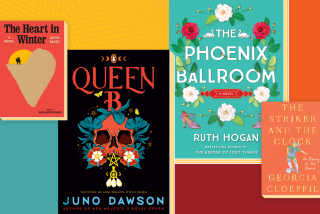Once Upon This Time
Edna O’Brien’s latest novel, “In the Forest,” has the atmosphere of a fairy tale. Not a Disney fairy tale with cute singing dwarfs but the ancient, scary kind that started out with the death of a mother, because mothers died often in childbirth in the old days. These stories featured ogres in dark woods and princesses imprisoned in impregnable towers to protect their chastity. Terrible things happened to small children.
In this case, the ogre is Michen O’Kane, a crazed serial killer whose mother died when he was young. A German resident in the Irish county where O’Kane has gone on a murderous rampage labels him “Kinderschreck,” or child-frightener, a goblin from German folklore who sometimes ate children. The princess is the free-spirited, beautiful Eily Ryan, who has the flaming golden-red hair and “body white as milk” of princesses down the ages. The child is Maddie, her son.
Set in contemporary rural Ireland, “In the Forest” is based on a true story, as are several of O’Brien’s recent novels, such as “Down by the River,” a retelling of the “X” case which changed Ireland’s abortion laws, and “House of Splendid Isolation,” based on the real-life story of an Irish Republican Army terrorist. These more recent books mark a change from her earlier work which had the London-based writer recalling her Irish girlhood.
“In the Forest” is slightly different from these other retellings in that it has at its core the old archetypal battle between good and evil, with one man as a force for primeval chaos, a man so hurt and twisted that he is beyond salvation. (Some say O’Kane is a horned devil who has come to punish the world for its sins. He even cuts off the head of a priest.) Every aspect of this world has both a benevolent and malevolent example. The harmless fantasy games of children mirror the vicious actions of an adult out of touch with reality. Mother-and-son relationships are represented by the claustrophobic closeness between young O’Kane and his mother and by the sunny playfulness Eily enjoys with her son.
Eily’s decision to live alone with Maddie as a way to keep her independence is not only complicated by her yearning for love but also blighted by O’Kane’s lust, just as princesses of old were threatened by lascivious monsters. He calls her “goat girl” (the animal was an ancient symbol of unbridled carnality). The book opens with a description of the dark forest (where a horrible crime is committed) with a rotting dead goat at its center, symbolic of the loss of its “old innocence.”
Yet the book is also thoroughly modern. O’Brien is a superb storyteller, and “In the Forest” has the pacing of a suspense thriller, even though we know at the outset what will happen. She even plays with modern mythology. When O’Kane captures Eily and Maddie and takes them into the forest, he starts talking like a crazed cowboy film villain. The story is threaded with modern sociological and psychological concerns as well. Over and over again, through his actions, O’Kane revisits his father’s abuse and the loss of his mother, who was depressive and suicidal. He smashes the eggs in a thrush’s nest and flattens the newborn kittens that belong to the one family that shows him love.
But throughout the work, there are moments when one gets a sense of unease. One can’t help thinking: This troubled young man is not an archetype for evil. Sure, some people see mental illness that way, especially when a killer is involved, and O’Brien often makes it clear that she is relaying a variety of viewpoints, including those of the police, who want to repay O’Kane’s violence with more violence, and the local people, who think he has unnatural powers. But at times O’Brien, as the narrator, appears to be presenting that viewpoint too. As O’Kane starts laughing manically in the police car soon after he is caught, “a shaft of terror” passes through the officers, “witnesses to some medieval grotesquerie: his grinning face, his loathsome eyes with a dead yet murderous glare.
“They are afraid of him now, the Kinderschreck, one of their own sons come out of their own soil, their own flesh and blood, gone amok.”
No, one wants to say: O’Kane is a human being with a terrible history. He was molested by priests he trusted, raped in jail. Now he is suicidal and hears voices. Suddenly, the fairy tale symbolism feels imposed.
Part of the problem lies in the fact that the book mirrors almost exactly a real event, as a blurb notes at the end of the book: the murder of Imelda Riney, 29, and her 3-year-old son, Liam, who were shot to death by Brendan O’Donnell in the woods of County Clare in 1994. O’Kane, like O’Donnell, is convicted of murder and sentenced to life. Like O’Donnell, his insanity defense is rejected and, after several suicide attempts, he is moved to a mental hospital, where he dies of a heart attack after a change in his medication. Perhaps if “In the Forest” were entirely fiction, the reader would feel horror, but not the kind of outrage that comes from knowing the reality of the systemic injustice suffered by O’Donnell, which makes the fairy tale rendering harder to take.
That is not to say that the tale isn’t breathtakingly told in O’Brien’s typically graceful, emotionally gripping style that stays just this side of melodrama. It is a story rooted in real feelings and truthful description, like that of O’Kane’s round tin box that once held floor polish, now filled with “bullets, brass-coated, their snouts close together” which Maddie pores over, fascinated, as any boy would be--even though O’Kane is about to kill him. Despite the fairy tale framework that butts up against the reality of O’Kane’s troubled life, “In the Forest” can’t help but lure the spellbound reader onward from one gritty or dream-laden scene to the next.
More to Read
Sign up for our Book Club newsletter
Get the latest news, events and more from the Los Angeles Times Book Club, and help us get L.A. reading and talking.
You may occasionally receive promotional content from the Los Angeles Times.







